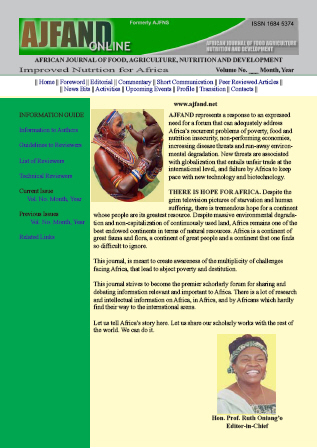
|
African Journal of Food, Agriculture, Nutrition and Development
Rural Outreach Program
ISSN: 1684-5358
EISSN: 1684-5358
Vol. 17, No. 1, 2017, pp. 11477-11496
|
 Bioline Code: nd17006
Bioline Code: nd17006
Full paper language: English
Document type: Research Article
Document available free of charge
|
|
|
African Journal of Food, Agriculture, Nutrition and Development, Vol. 17, No. 1, 2017, pp. 11477-11496
| en |
AN ADAPTIVE HOUSEHOLD SAMPLING METHOD FOR RURAL AFRICAN COMMUNITIES
Awuah, R; Douglass, R; Agyepong, S & Kuwornu, E
Abstract
Investigators working in rural communities and small towns in Africa face many obstacles to obtaining a random and representative sample of households for their research. The civic infrastructure used as the building blocks of survey sampling in developed countries are mostly absent in rural Africa. The purpose of the study described in this paper was to pilot an innovative and cost-effective approach to household sampling designed to generate probability samples representative of the socio-economic diversity of the small town of Berekuso, in the Eastern Region of Ghana, without relying on existing census data, household registers, or a regular layout of roads and dwellings. Utilizing Google Earth images and a Graphical Information System (GIS) map of Berekuso, sampling units were defined as 15-degree wedge-shaped sectors radiating from the center of the original township. All households within randomly selected sectors were surveyed, and based on a household classification scheme, each household type was identified. Additional sectors were randomly selected and surveyed in sequence until no new household types were identified – a notion recognized by laboratory scientists as an ‘end point’. The adaptive sampling strategy was cost and time effective: freely available versions of Google Earth and QGIS software were employed along with inexpensive handheld Global Positioning System (GPS) devices; a total of 57 households were surveyed by teams of two enumerators over three consecutive Sundays. The survey method yielded a probability sample that is representative of the socioeconomic diversity of Berekuso, and produced generalizable results for median household size, median age of residents, sources of potable water and toilet types, among others. For example, based on the results of the survey, a 95% confidence interval estimate of the proportion of residents of Berekuso under the age of 20 years is between 0.49 and 0.58. These figures are consistent with results of Ghana’s 2010 census which pegged the proportion of the population of the Eastern Region under the age of the 20 years at 0.49. The authors believe that the methodology described in this paper may be applicable to household research in many rural African villages and small towns where little civic infrastructure exists to create more traditional sampling frames.
Keywords
Google Earth; area sampling; household survey; impact evaluation; wealth ranking
|
| |
© Copyright 2017 - African Journal of Food, Agriculture, Nutrition and Development
Alternative site location: http://www.ajfand.net/
|
|
